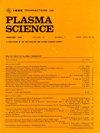小电流下分子气体直流开关电弧的实验研究
IF 1.5
4区 物理与天体物理
Q3 PHYSICS, FLUIDS & PLASMAS
引用次数: 0
摘要
电弧在分子气体中的行为,特别是在氢(H2)气体中,仍然没有完全理解,缺乏实验研究。在这项工作中,我们研究了氮气(N2)和氢气(H2)气体中直流(dc)开关电弧的电弧行为,并给出了实验结果,重点研究了2到16 A的小电流。实验用石墨电极在常压下进行,电极间隙长度可达2.8 mm。在恒流条件下测量电弧电压,并对高速摄像机图像进行处理,估算电弧长度。引入了电压与长度之间的关系,给出了平均电场。对比分析N2和H2的电弧行为表明两种放电方式存在预期的差异。在H2中观察到不稳定的电弧行为、快速的延伸和更高的电场。在N2中,低长度处的平均电场大于高长度处的平均电场,而在H2中,无论弧长如何,电场都是恒定的,并且弧柱更窄。最后,建立了两种气体的电弧电压电流模型,并与实验结果进行了比较。本文章由计算机程序翻译,如有差异,请以英文原文为准。
Experimental Investigation of DC Switching Arcs in Molecular Gases at Small Currents
The behavior of an electric arc in molecular gases, particularly in hydrogen (H2) gas, is still not fully understood and lacks experimental investigations. In this work, we studied the arc behavior and presented experimental results of direct current (dc) switching arcs in nitrogen (N2) and hydrogen (H2) gases, focusing on small currents ranging between 2 and 16 A. The experiments were performed with graphite electrodes at atmospheric pressure and with a gap length of up to 2.8 mm. The arc voltage was measured at constant current and the arc length was estimated via processing of high-speed camera images. A relationship between the voltage and the length is introduced, which gives the average electric field. The comparative analysis of arc behavior in N2 and H2 indicates expected differences between both discharges. Erratic arc behavior, fast elongations, and higher electric fields are observed in H2. In N2, the average electric field at low lengths is higher than at higher lengths, whereas in H2, the field is constant regardless of arc length and the arc column is more constricted. Finally, an arc voltage–current model is presented for both gases and compared with experimental results.
求助全文
通过发布文献求助,成功后即可免费获取论文全文。
去求助
来源期刊

IEEE Transactions on Plasma Science
物理-物理:流体与等离子体
CiteScore
3.00
自引率
20.00%
发文量
538
审稿时长
3.8 months
期刊介绍:
The scope covers all aspects of the theory and application of plasma science. It includes the following areas: magnetohydrodynamics; thermionics and plasma diodes; basic plasma phenomena; gaseous electronics; microwave/plasma interaction; electron, ion, and plasma sources; space plasmas; intense electron and ion beams; laser-plasma interactions; plasma diagnostics; plasma chemistry and processing; solid-state plasmas; plasma heating; plasma for controlled fusion research; high energy density plasmas; industrial/commercial applications of plasma physics; plasma waves and instabilities; and high power microwave and submillimeter wave generation.
 求助内容:
求助内容: 应助结果提醒方式:
应助结果提醒方式:


